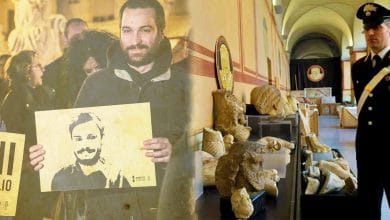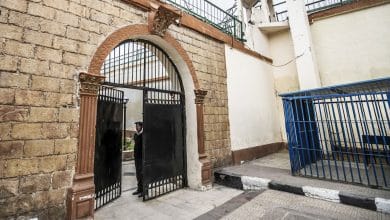
The sale of the head of Tutankhamun at an auction in London in July 2019 provoked angry reactions from a wide range of Egyptians, which is good in itself, but reviewing these responses shows that most of them were misplaced; which indicates that we are in urgent need to raise Egyptians’ awareness of the reality and status of Egyptian antiquities both at home and abroad.
Officials of the Egyptian Ministry of Antiquities come out – after every similar incident – to the world with many fiery statements threatening and warning auction houses against allowing the sale of these antiquities. However, they have never succeeded to implement any of their threats or stop sale of Egyptian antiquities abroad, for one simple reason that these auction houses cannot advertise the sale of Egyptian or non-Egyptian artifacts without verifying their ownership titles.
First: Smuggling Egyptian antiquities abroad
A- Smuggling Egyptian antiquities started at the time of Roman occupation
The smuggling of Egypt’s antiquities abroad dates back to the time of the Roman occupation of Egypt in 32 BC. The Romans were so stunned by the attractiveness and magnificence of ancient Egyptian civilization that they started to smuggle Egyptian artifacts out of the country. The Roman Emperor Hadrian (r.117-138 AD) beautified Rome’s gardens and squares with Egypt’s Pharaonic monuments. The Emperor Constantine the Great (r. 306-337 AD) seized the obelisk of King Thutmose III which was in Thebes and then transferred it to Alexandria and then to Constantinople, which is currently located next to the Hagia Sophia mosque in Istanbul. The Roman Emperor Maximus (r. 286-310 AD) transferred another pharaonic obelisk to Rome, which fell and was re-erected during the reign of Pope Sixtus V in 1587.
B- Modern times and the West’s obsession with Egypt antiquities:
In the modern era since the sixteenth century AD, Europeans have been fascinated by Egypt’s antiquities and treasures, and always wanted to transfer them to their own countries, on the pretext that they are more able to preserve them as a world heritage, claiming – and they may be right in this claim – that successive Egyptian governments as well as the Egyptian people are not aware of the value of their country’s treasures – a claim that was convincing to some Egyptian officials and scholars. The Europeans took advantage of this climate in smuggling Egyptian antiquities and treasures as much as possible. Foreigners’ appetite for Egyptian antiquities even prompted Egyptian people to sell artifacts to them to get money[1].
During the 18th century, the looting of Egyptian antiquities escalated at the hands of foreign politicians, diplomats and even clergy men, such as: Saint Fansleb, who was a deputy of Louis XIV, the English physician Hanselson, one of the founders of the British Museum in 1756, and Queen Marie Antoinette of France (in 1755), who – being very fond of Egyptian antiquities – ordered transference of a number of Egyptian artifacts to the royal palaces in France.
With the advent of the French occupation of Egypt at the end of the 18th. century, interest increased in the Egyptian antiquities, whether visible or buried, especially with the establishment of the French Academy of Sciences, which focused on collecting everything related to Egypt, particularly the Egyptian antiquities.
When the French campaign in Egypt was preparing to quit Egypt, and during withdrawal negotiations between the French and the British, the British commander Hutchinson stipulated that the French forces must hand over the Egyptian antiquities they had collected and prepared to transfer to France. Earl Cavan, the commander of the British forces in Alexandria, ordered the transfer of Pharaonic obelisk to London to celebrate the failure of the French campaign; the obelisk that decorates one of the most important squares of London today[2].
C- The Family of Muhammad Ali Pasha and offering antiquities as gifts
– After the arrival of Muhammad Ali Pasha to power in Egypt, he sought to seek friendship with European leaders by offering Egyptian antiquities as gifts to them, including:
- During the visit of King Charles V of France to Luxor Temple in 1828, he was impressed by two obelisks of Ramesses II that were erected in the temple; which led Muhammad Ali Pasha to offer him one of them as a gift.
- Muhammad Ali Pasha gave both the UK and France two obelisks of Cleopatra in Alexandria to win supporting him against the Ottoman Sultan at the time.
- Muhammed Ali Pasha offered Egyptian antiquities, including mummies and crocodiles, as gifts to Saint S. Jerome who was on a visit to Egypt in 1833.
– In 1855, the Vali (ruler) of Egypt, Abbas Pasha, offered a member of the Austrian royal family, Archduke Maximilian, a hall filled with Egyptian antiquities as a gift; which were all transferred to Vienna.
– In 1912, Borchardt, a German archaeologist, discovered the statue of Nefertiti, a gypsum statue of a royal princess dating back to the 14th. century BC, and was transferred it to Germany.
– Howard Carter and Lord Carnarvon stole some artifacts from the tomb of Tutankhamun, many of which are exhibited now in the Metropolitan Museum.
D- Pos- July 1952, smuggling of antiquities continued:
– In the 1960s, President Gamal Abdel Nasser gave some artifacts as gifts to countries and official bodies, including five temples dedicated to the countries that participated in the construction of the High Dam.
– President Anwar Sadat gave more than 100 artifacts to some world leaders, including Shah of Iran Mohammad Reza Pahlavi in 1971, former US Secretary of State Henry Kissinger in 1973 and former French President Giscard d’Estaing in 1975.
– Gihan Sadat, wife of President Anwar Sadat, donated some Pharaonic artifacts to both Imelda Marcos, wife of the former President of Philippine, and also to the wife of the then President of Mexico[3].
– During the era of President Hosni Mubarak and beyond, the illegal smuggling of Egyptian antiquities abroad has continued.
Second: Legislation related to smuggling Egyptian antiquities abroad
1- On 15 August 1835, Muhammad Ali Pasha issued a decree prohibiting completely the export or trade of all Egyptian antiquities.
2- Muhammad Ali Pasha issued another decree in the same year to establish a museum of antiquities, called the “Azbakia Museum”, and assigned the task of its management to Refa’ah al-Tahtawi, who issued a decree banning the export of antiquities or smuggling them abroad[4].
3- In early January 1855, Said Pasha issued a decree prohibiting excavation for antiquities for persons or bodies other than the government, in order to preserve Egypt’s antiquities and prevent their smuggling.
4- In 1858, Said Pasha ratified the establishment of the Antiquities Authority, in attempt to face the continued illegal trade in Egyptian antiquities[5].
5- Khedive Ismail agreed to establish the first national museum in the Middle East, which was opened in 1863 as a temporary government building in the region of Bulaq, Giza.
6- In March 1869, the list of “archaeological objects” was issued, including seven articles prohibiting any excavations except with an official license from the Ministry of Public Works, and prohibiting the export of antiquities.
7- In 1874, a new regulation was issued allowing the system of dividing the discovered antiquities into two equal parts, i.e. 50% for the discovering mission and 50% for the Egyptian State.
8- In 1880, a new decree was issued banning the export of antiquities due to the increasing number of foreigners that smuggle antiquities abroad.
9- In 1897, Khedive Abbas Helmi II laid the foundation stone of the Egyptian Museum; and in 1902 the construction of the Egyptian Antiquities Museum was completed.
But all this did not stop smuggling the Egyptian antiquities abroad.
10- Khedive Abbas Helmi II issued the Law of Protection of Antiquities No. 14 of 1912, but this law could not prevent smuggling, because of its loopholes, including an article allowing the discoverer of antiquities the right to sell and smuggle antiquities abroad[6].
11- Khedive Fouad issued Law No. 8 of 1918 for the Protection of Antiquities of the Arab Era. But the law gave the discoverer the right to sell and smuggle antiquities abroad, as did the previous law 14 of 1912[7].
12- In 1951, King Farouk issued Law No. 215 of 1951, which aimed to establish decisive practical measures to put an end to the illegal trade in antiquities, but included many loopholes that helped smuggle antiquities abroad, allowing for the exchange of, or sale of, duplicated movable antiquities with museums or persons. The law also allowed antiquities trade and exportation after obtaining a permit from the Ministry of Education[8].
13- In 1953, with the withdrawal of the British occupation forces from Egypt, the Egyptian Antiquities Authority has been run purely by Egyptian government. The authority’s first Egyptian director was Mr. Mostafa Amer, who took office in 1953 and lasted about 3 years. In 1971, the Antiquities Department became the Egyptian Antiquities Authority. During these periods, most of the Egyptian antiquities smuggled abroad had been offered as gifts by Egyptian officials to foreigners.
14- In 1983, Law No. 117 of 1983[9] was issued, the first actual law that sought preventing smuggling of antiquities abroad. However, it also gave a whole year transitional period before banning the antiquities trade, which gave smugglers an opportunity to speed up the process of trafficking. It also allowed the exchange of artifacts with foreign countries, and opened the door for granting individuals permissions to carry out excavations, which played a major role in smuggling Egyptian antiquities abroad. The law also led legalization of smuggling antiquities abroad through grants and bonuses.
15- Act No. 117 of 1983 was amended several times. However, all these amendments did not amend the articles that legalized the process of smuggling abroad, including Law No. 12 of 1991[10] and Law No. 3 of 2010[11], although the second amendment has put significant restrictions in the third part of its executive regulations for organizing the work of foreign missions operating in Egypt.
16- Law No. 91 of 2018, the last amendment to Law 117 of 1983[12], included in the tenth article a provision allowing the establishment of a committee for foreign exhibitions, but this article did not specify exactly how to preserve the artifacts displayed abroad. The law stated in Article 31 that the Ministry of Defense, not the security services, has the final word in allowing foreign missions to excavate for antiquities. Although the last amendment to Article 41 raised the value of the fines and the imprisonment of anyone who smuggled antiquities outside Egypt, but the legislator included a phrase in the article that would help the defendant to fully repudiate the charge, i.e. “… anyone who smuggled antiquities outside Egypt while being well-aware of that … “.
Third: Causes of smuggling Egyptian antiquities and proposed solutions
It has been clear from the above presentation that the smuggling of Egyptian antiquities dates back to the time of the Roman Empire. We have also seen that the laws issued by successive governments for the protection of Egyptian antiquities did not succeed in stopping the smuggling of antiquities abroad, although some governments have strived to do so. However, we consider that these laws did not only fail to reserve Egyptian antiquities, but they at some time legalized the process of smuggling them abroad.
A- Causes
In addition, there were some other factors behind the smuggling of Egyptian antiquities abroad, but most of them remained linked to the loopholes of the laws that we have discussed above. The smuggling of Egyptian antiquities abroad was the result of a number of reasons, which can be summarized in the following points:
1- Lack of awareness of the importance of Egypt’s history and civilization, particularly the Egyptian antiquities of all eras.
2- Obsession of the West with Egyptian antiquities, and their rush to owning them in all possible ways, in exploitation of the weakness of the Egyptian state.
3- Foreigners’ belief that they are more capable of preserving the Egyptian antiquities than the Egyptians.
4- Egyptian officials and scholars that have been deceived by the argument of foreigners that Europeans are able to preserve the Egyptian heritage more that the Egyptians themselves.
5- Those responsible for the protection of Egyptian antiquities at some time in the past were foreigners, especially of the French nationality.
6- Foreign diplomats’ exploitation of their relationship with Egyptian officials in the transfer of many Egyptian antiquities to their countries.
7- The laws issued for the protection of Egyptian antiquities are considered one of the reasons behind facilitating the process of smuggling them abroad, as we have explained above.
8- The gifts offered by officials to foreign leaders and officials and attempts to legalize them through articles of laws.
9- Successive Egyptian governments have allowed foreigners to excavate for antiquities individually and legalized this through laws, allowing them to transfer much of Egypt’s antiquities abroad.
10- The ill-fated role of foreign missions, especially under the laws that allowed them to obtain 50% of the artifacts they discover.
B- Proposed solutions
Following are proposals for stopping the smuggling of Egyptian antiquities abroad and try to restore Egyptian antiquities exhibited in museums abroad and beautifying squares in Europe and America:
1- The antiquities protection laws should address how to restore the Egyptian antiquities that were smuggled abroad during the foreign occupation of Egypt, taking advantage of Article XI of the 1970 UNESCO Convention on the Means of Prohibiting and Preventing the Illicit Import, Export and Transport of Ownership of Cultural Property, in this regard.[13]“
2- To seek help from UNESCO in general on this issue, especially that the second article of the above-mentioned Convention which states that:
“The States Parties to this Convention recognize that the illicit import, export and transfer of ownership of cultural property is one of the main causes of the impoverishment of the cultural heritage of the countries of origin of such property and that international co-operation constitutes one of the most efficient means of protecting each country’s cultural property against all the dangers resulting there from. To this end, the States Parties undertake to oppose such practices with the means at their disposal, and particularly by removing their causes, putting a stop to current practices, and by helping to make the necessary reparations.”
Article III of the UNESCO Convention also states that: “The import, export or transfer of ownership of cultural property effected contrary to the provisions adopted under this Convention by the States Parties thereto, shall be illicit.[14]” All these articles and others must be utilized in this regard.
3- The Egyptian government should also take advantage of the UNESCO’s ‘Convention Concerning the Protection of the World Cultural and Natural Heritage’, adopted in 1972, which states that:
“parts of the cultural or natural heritage are of outstanding interest and therefore need to be preserved as part of the world heritage of mankind as a whole.”[15].
Although Egypt is a key member of this agreement, the benefits that are supposed to be gained from its membership are almost non-existent.
4- Restricting the work of foreign missions and increasing control over them, in addition to the need to omit the provision that refers to granting a reward to the missions by 10% of what was discovered during their excavations.
5- Some provisions of law articles that stand in the way of restoration of Egyptian antiquities abroad should be amended, including the second article of the last amended law No. 91 of 2018, which limits the definition of antiquities to those existing “on the Egyptian territories” to be “anywhere in the world”; thus, including the Egyptian antiquities abroad and helping the government to seek their restoration[16].
6- Article 8 of the law states that: “All antiquities shall be considered as public funds even if they are found outside Egypt (provided that their exit was unlawful), may not be owned or disposed of except in accordance with the conditions and procedures stipulated in this Law and its executive regulations and the resolutions implementing it.”
However, this article should be amended, changing the phrase: “provided that their exit was unlawful” to become: “regardless of the way they exited the country”, considering all Egyptian antiquities abroad Egyptian public funds exactly like Egyptian antiquities at home[17].
7- The government should work to raise awareness of citizens
of the importance of Egyptian heritage through media. The awareness-raising
process should be adopted by various ministries and competent bodies.[18]
Footnotes
[1] Brian M. Fagan – The Rape of the Nile: Tomb Robbers, Tourists, and Archaeologists in Egypt
[2] أشرف محمد حسن علي، الآثار المصرية المستباحة، دار الكتب والوثائق القومية، القاهرة 2016
[3] يوسف حامد خليفة، الآثار المصرية (قضايا ومضبوطات)، الهيئة المصرية العامة للكتاب، القاهرة 2012
[4] أشرف العشماوي، سرقات مشروعة: حكايات عن سرقة آثار مصر وتهريبها ومحاولات استردادها، الدار المصرية اللبنانية، 2012
[5] يونان لبيب رزق، مصر في عهدي عباس وسعيد، سلسلة التاريخ الجانب الآخر: إعادة قراءة للتاريخ المصري، دار الشروق، الطبعة الأولى 2007.
[6] أنطون صفير بك، محيط الشرائع -1856 -1952، المجلد الأول (من أ إلى ت) -صـ 5 (قانون رقم 14 لسنة 1912)
[7] الوقائع المصرية، العدد 31، 15 أبريل سنة 1918، (قانون رقم 8 لسنة 1918)
[8] الوقائع المصرية، العدد 105 في 12 نوفمبر 1951، (قانون رقم 215 لسنة 1951)
[9] الجريدة الرسمية، العدد 32، في 11 أغسطس 1983، (قانون رقم 117 لسنة 1983)
[10] الجريدة الرسمية، العدد 20، في 16 مايو 1991، (قانون رقم 12 لسنة 1991)
[11] الجريدة الرسمية، العدد 6 مكرر، في 14 فبراير 2010، (قانون رقم 3 لسنة 2010)
[12] الجريدة الرسمية، العدد 23 مكرر (أ) في 11 يونية 2018، (قانون رقم 91 لسنة 2018)
[13] اتفاقية بشأن الوسائل التي تستخدم لحظر ومنع استيراد وتصدير ونقل ملكية الممتلكات الثقافية بطرق غير مشروعة، المؤتمر العام في دورته السادسة عشر، منظمة اليونسكو، 12 أكتوبر 1970
[14] اتفاقية بشأن الوسائل التي تستخدم لحظر ومنع استيراد وتصدير ونقل ملكية الممتلكات الثقافية بطرق غير مشروعة، المؤتمر العام في دورته السادسة عشر، منظمة اليونسكو، 12 أكتوبر 1970
[15] اتفاقية لحماية التراث العالمي والثقافي والطبيعي، المؤتمر العام في دورته السابعة عشر، منظمة اليونسكو، 16 نوفمبر 1972
[16] الجريدة الرسمية، العدد 23 مكرر (أ) في 11 يونية 2018، (قانون رقم 91 لسنة 2018)
[17] صدى العرب، خبير آثار: بيع آثار مصر بالخارج جريمة يتحملها المجتمع الدولي واليونسكو، 06/يوليه/2019
[18] The views expressed in this article are entirely those of the author’s and do not necessarily reflect the views of EIPSS.
To Read Text in PDF Format Click here.



